Early museums began as the private collections of wealthy individuals, families or institutions of art and rare or curious natural objects and artifacts. These were often displayed in so-called wonder rooms or cabinets of curiosities. One of the oldest museums known is Ennigaldi-Nanna's museum, built by Princess Ennigaldi at the end of the Neo-Babylonian Empire. The site dates from c. 530 BCE, and contained artifacts from earlier Mesopotamian civilizations. Notably, a clay drum label—written in three languages—was found at the site, referencing the history and discovery of a museum item.
Modern museums first emerged in western Europe, then spread into other parts of the world. The first public museums were often accessible only by the middle and upper classes. It could be difficult to gain entrance. When the British Museum opened to the public in 1759, it was a concern that large crowds could damage the artifacts. Prospective visitors to the British Museum had to apply in writing for admission, and small groups were allowed into the galleries each day. The British Museum became increasingly popular during the 19th century, amongst all age groups and social classes who visited the British Museum, especially on public holidays.
The purpose of modern museums is to collect, preserve, interpret, and display objects of artistic, cultural, or scientific significance for the education of the public. From a visitor or community perspective, the purpose can also depend on one's point of view. A trip to a local history museum or large city art museum can be an entertaining and enlightening way to spend the day. To city leaders, a healthy museum community can be seen as a gauge of the economic health of a city, and a way to increase the sophistication of its inhabitants. To a museum professional, a museum might be seen as a way to educate the public about the museum's mission, such as civil rights or environmentalism. Museums are, above all, storehouses of knowledge.
Museums can vary based on size, from large institutions covering many of the categories below, to very small institutions focusing on a specific subjects, such as a specific location, a notable person, or a given period of time. Museums can also be categorized into major groups by the type of collections they display, to include fine arts, applied arts, craft, archaeology, anthropology and ethnology, biography, history, cultural history, science, technology, children's museums, natural history, botanical and zoological gardens. Within these categories, many museums specialize further, e.g. museums of modern art, folk art, local history, military history, aviation history, philately, agriculture, or geology.

